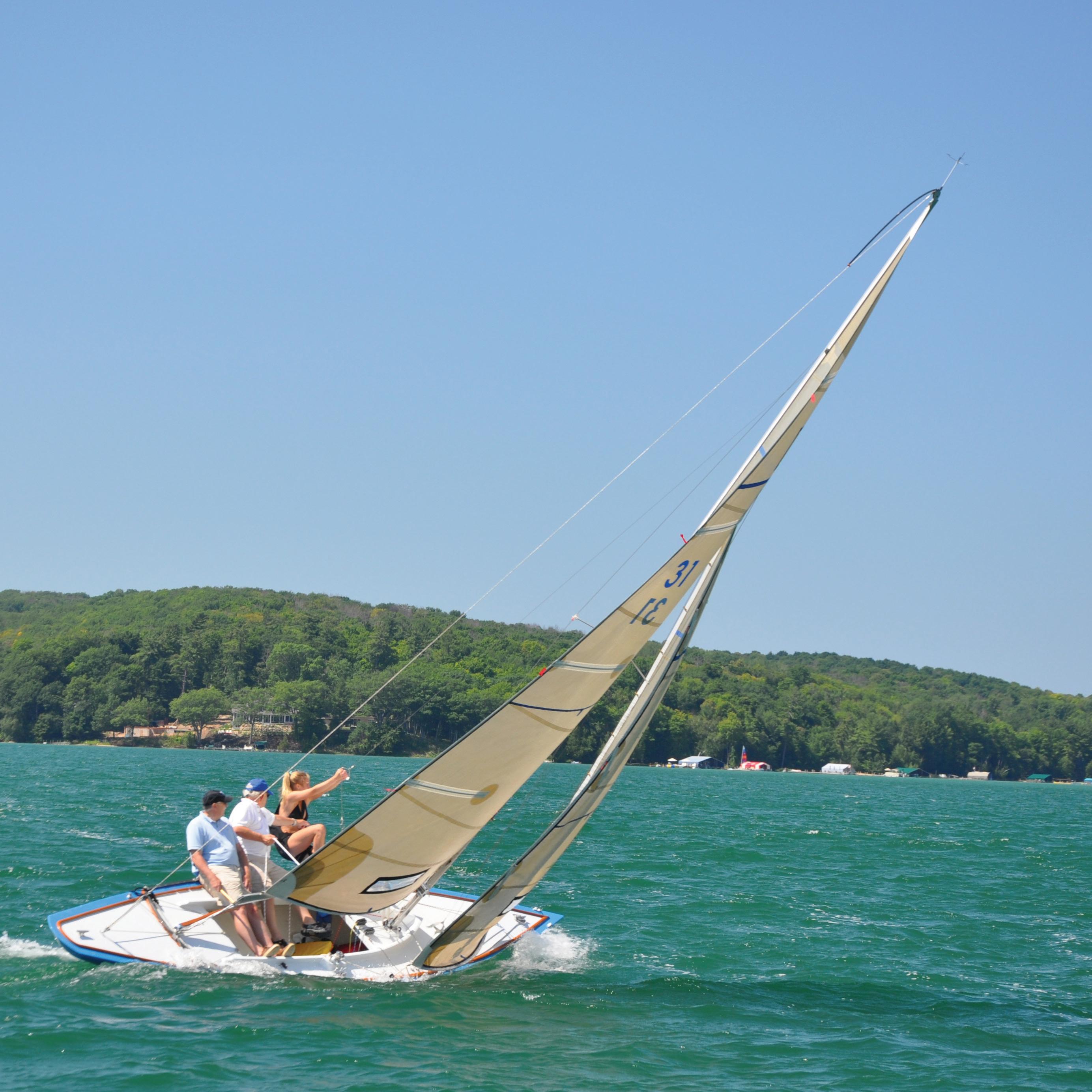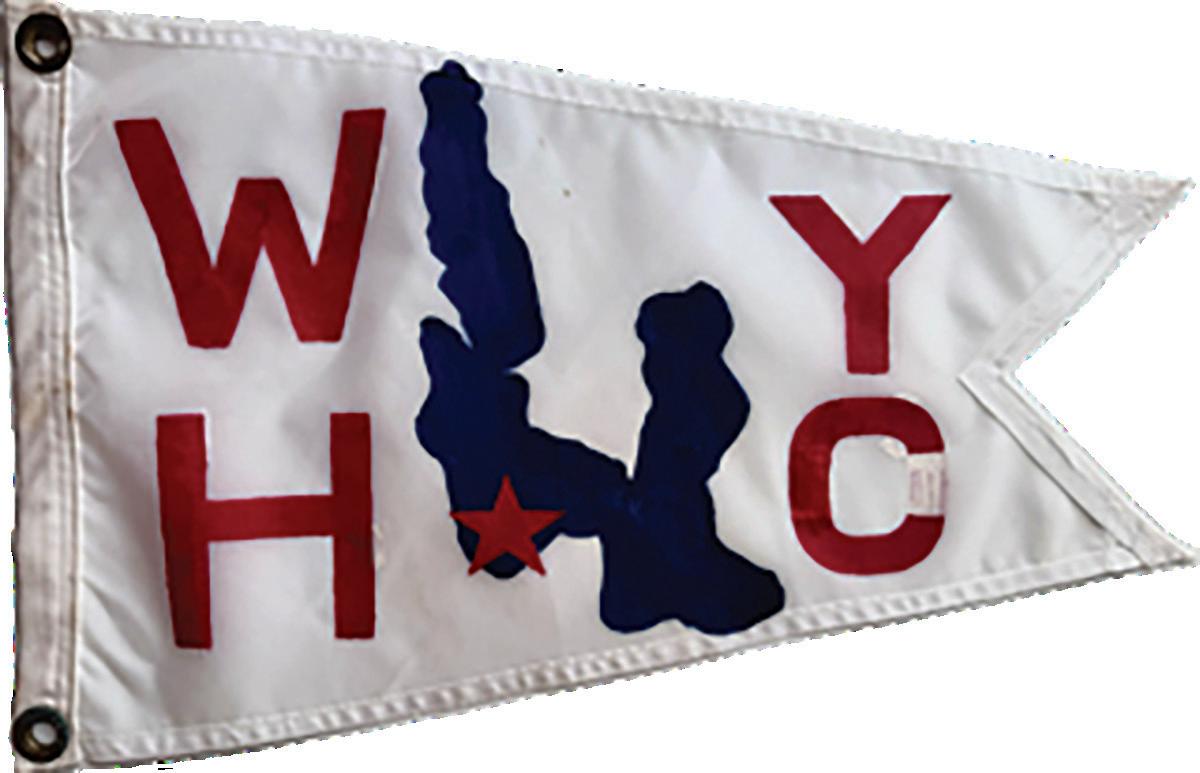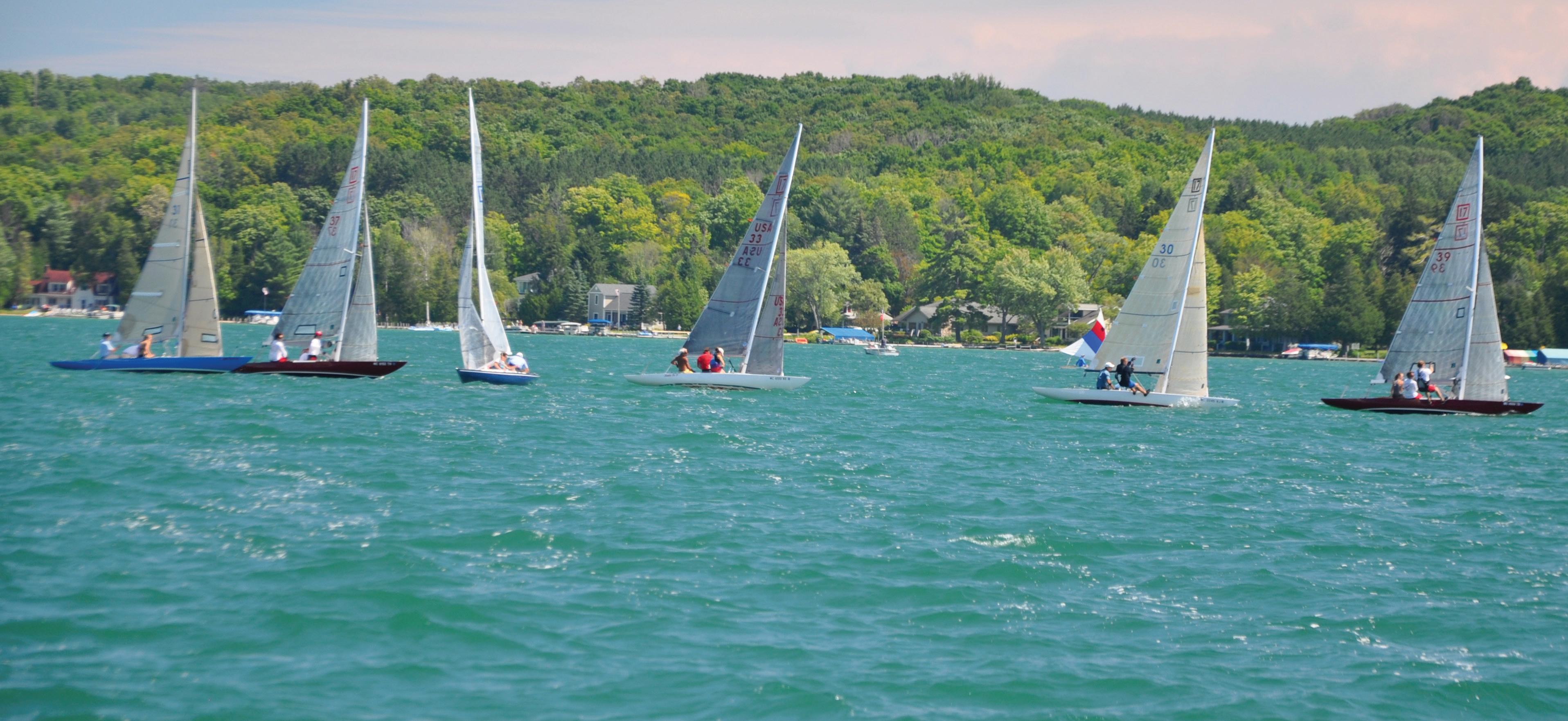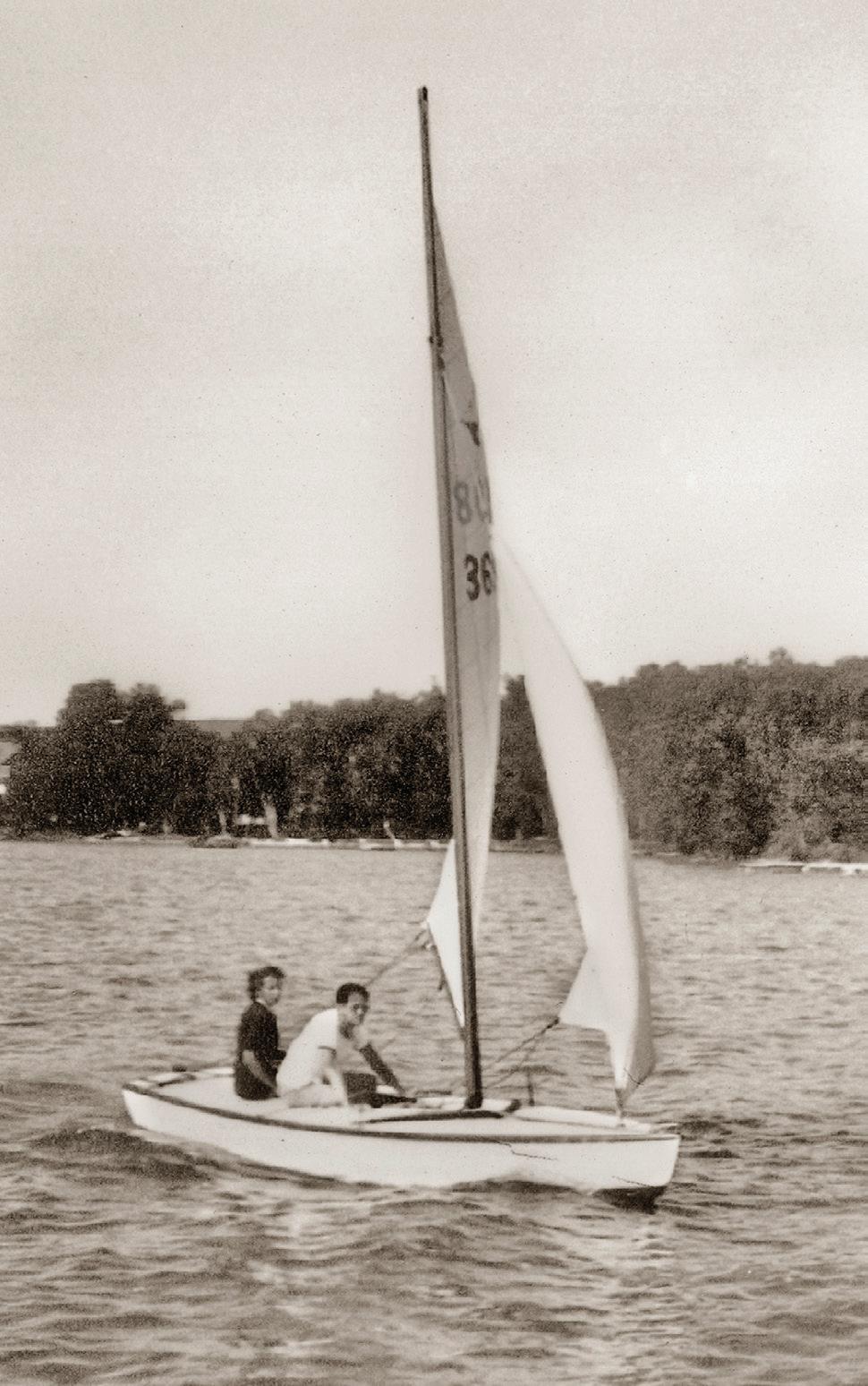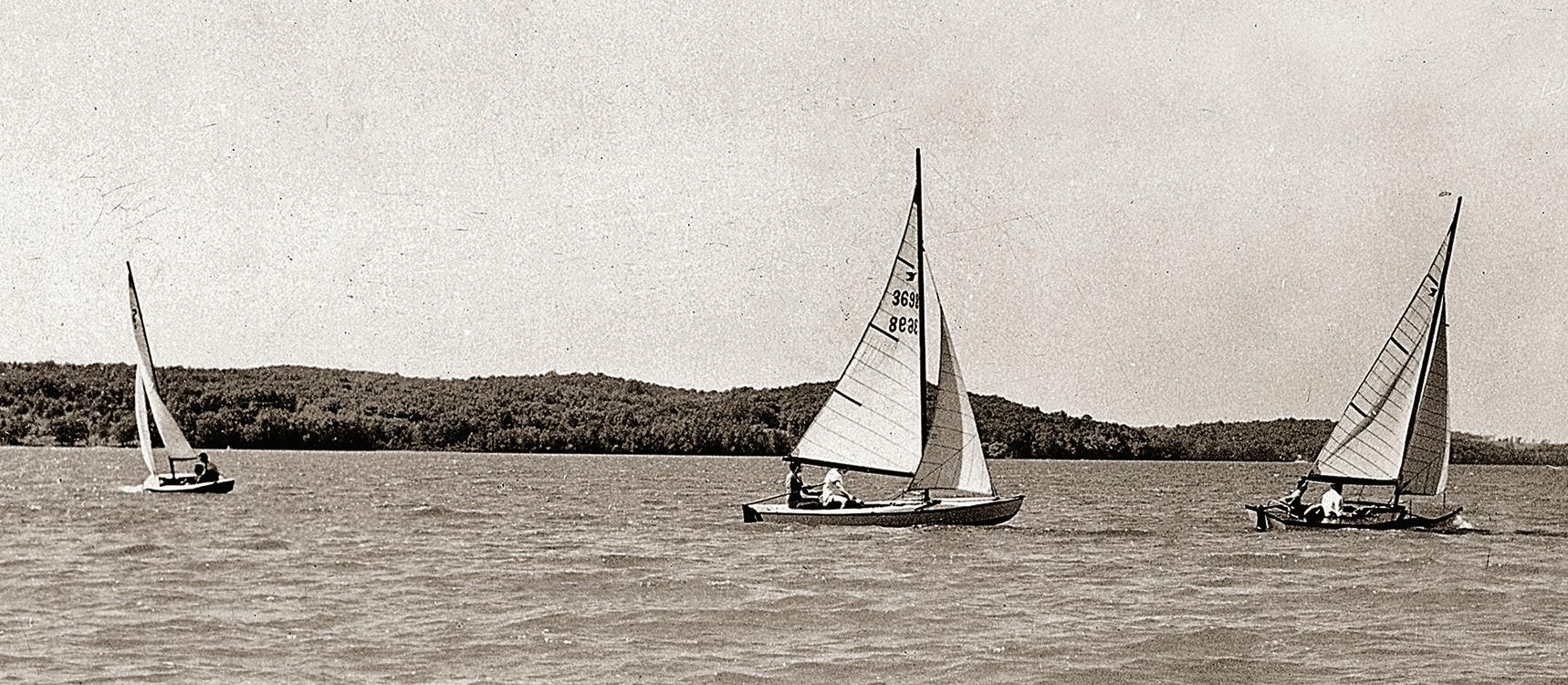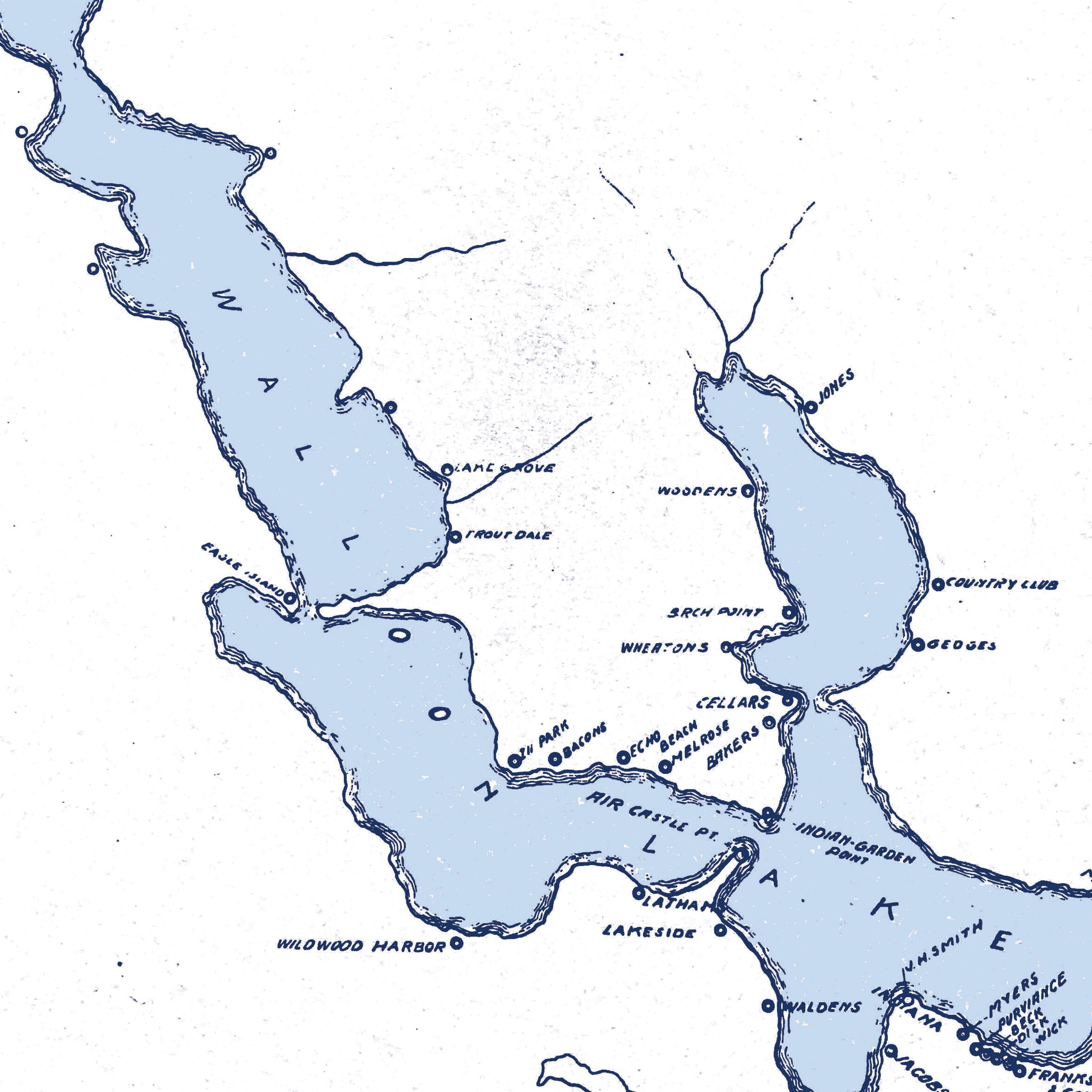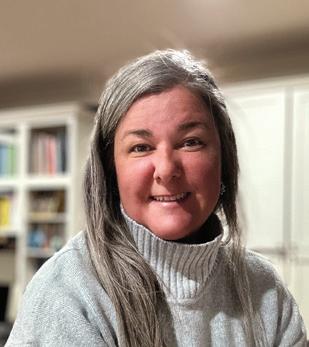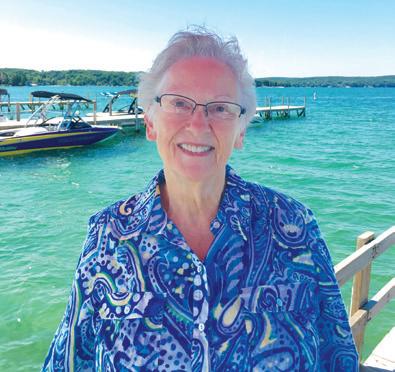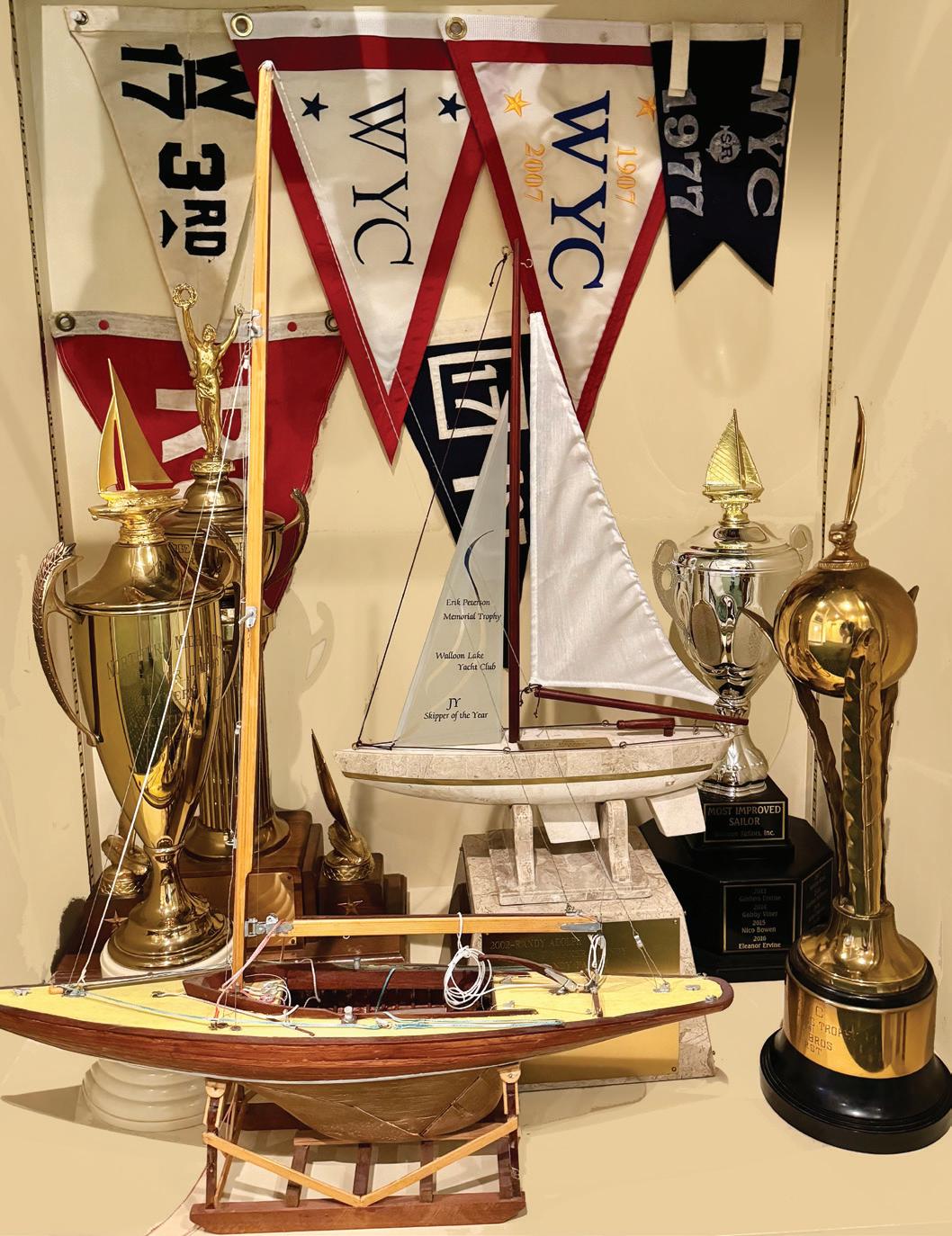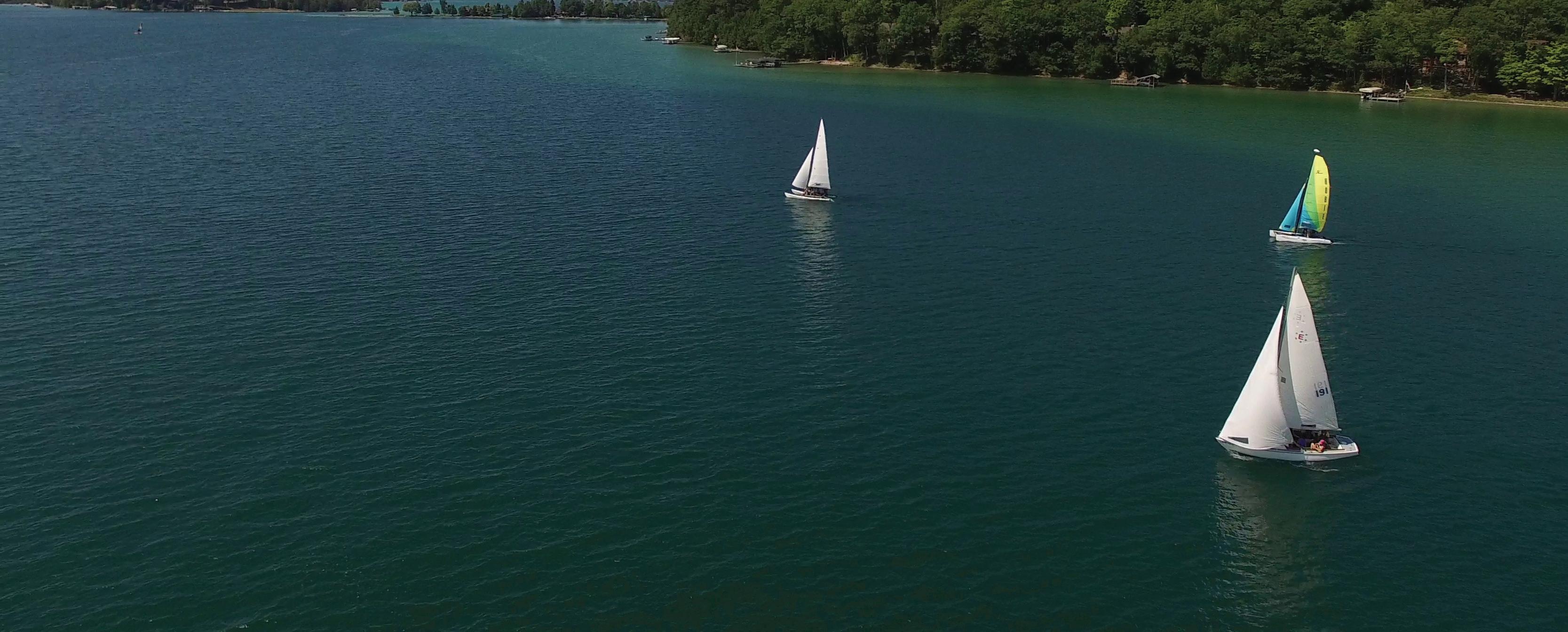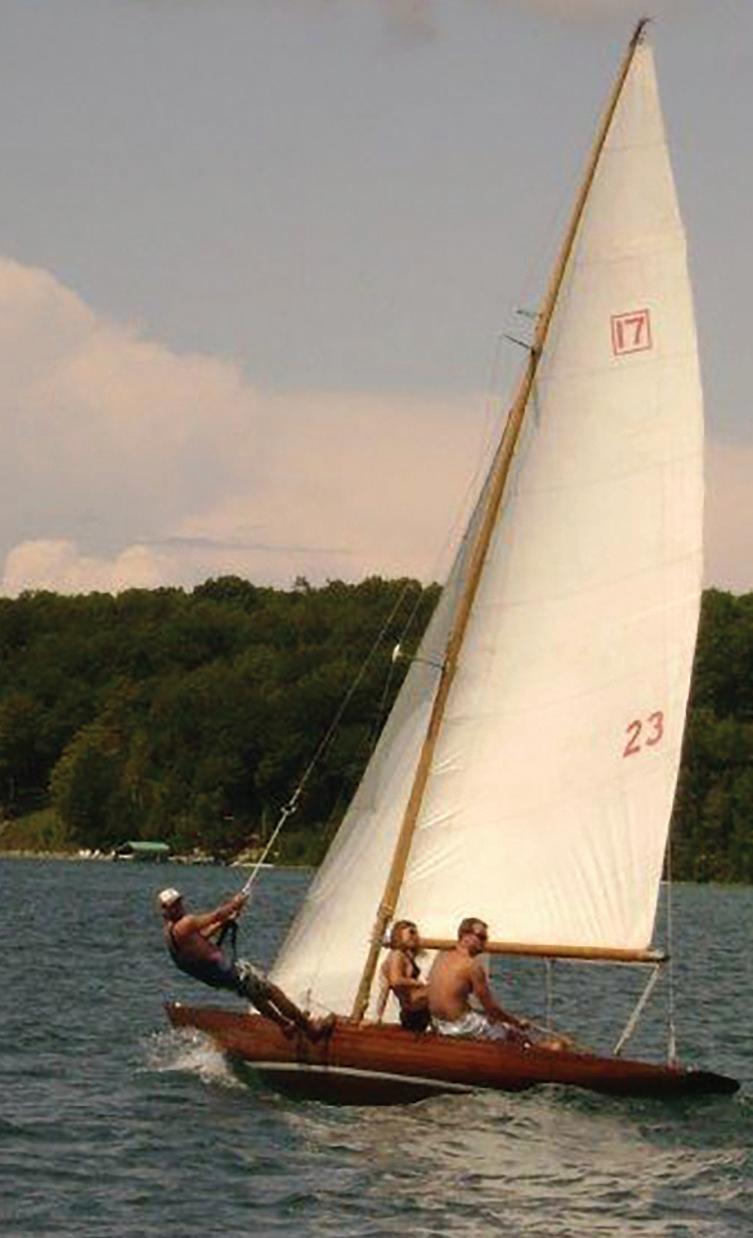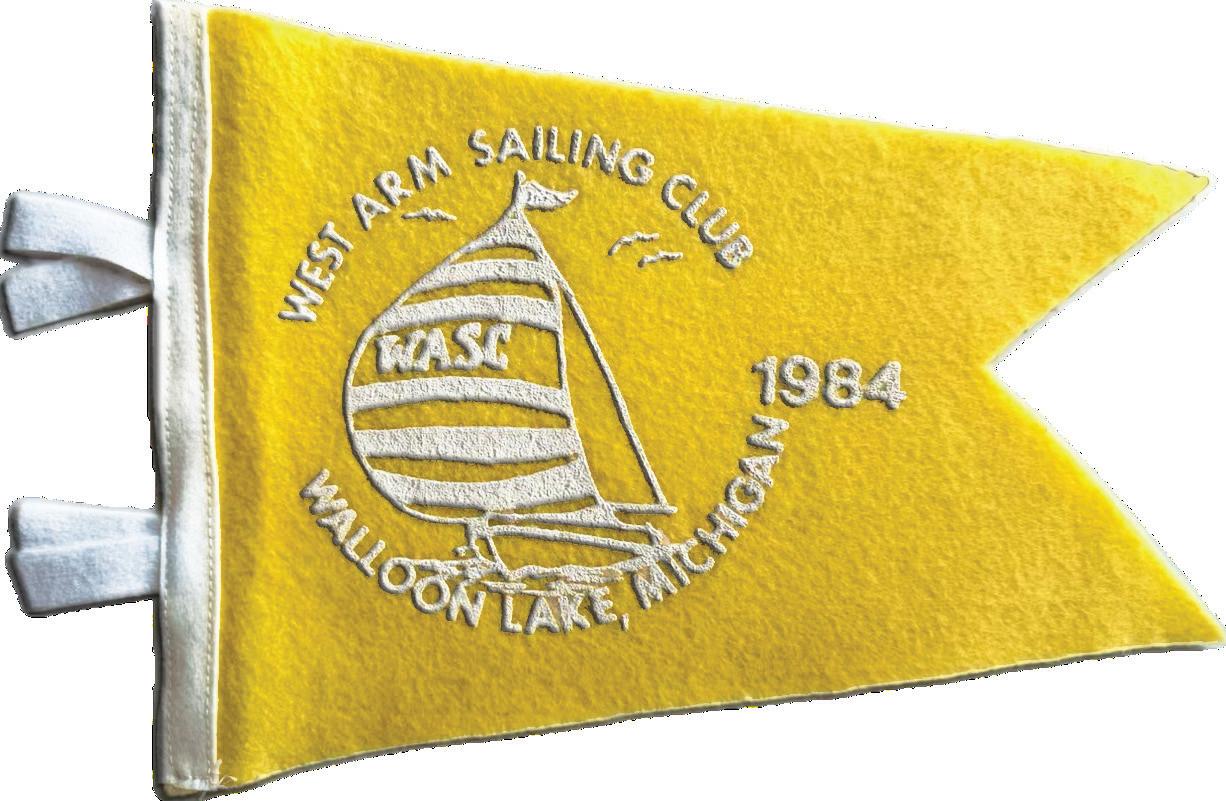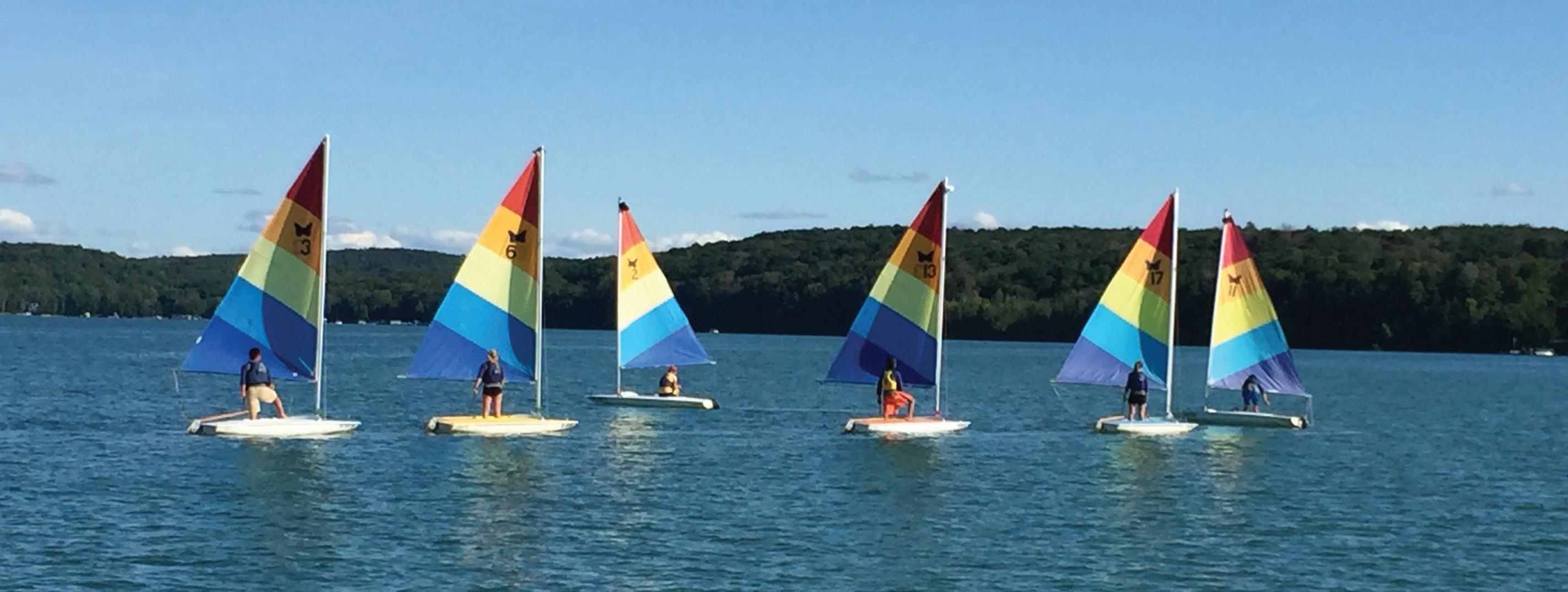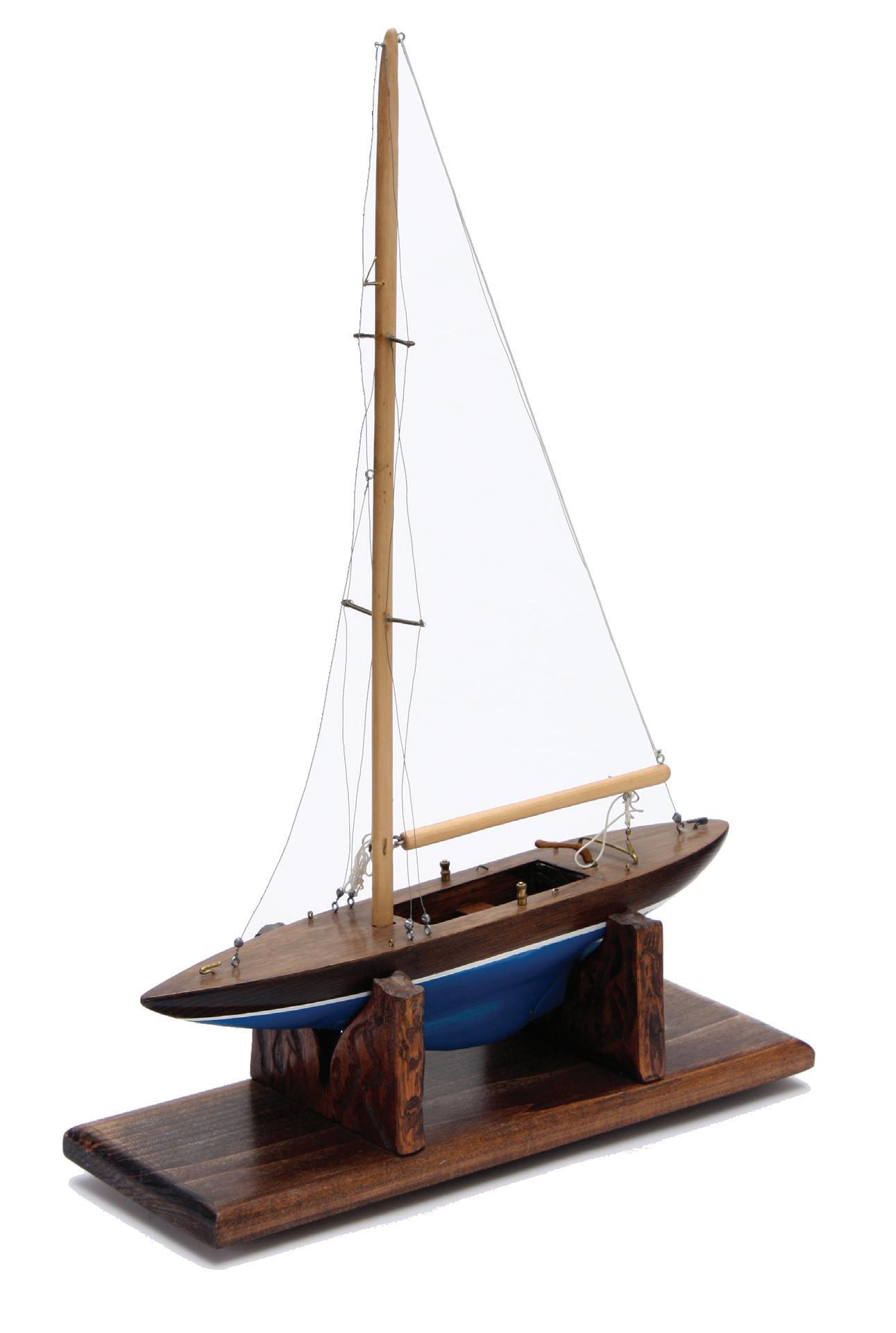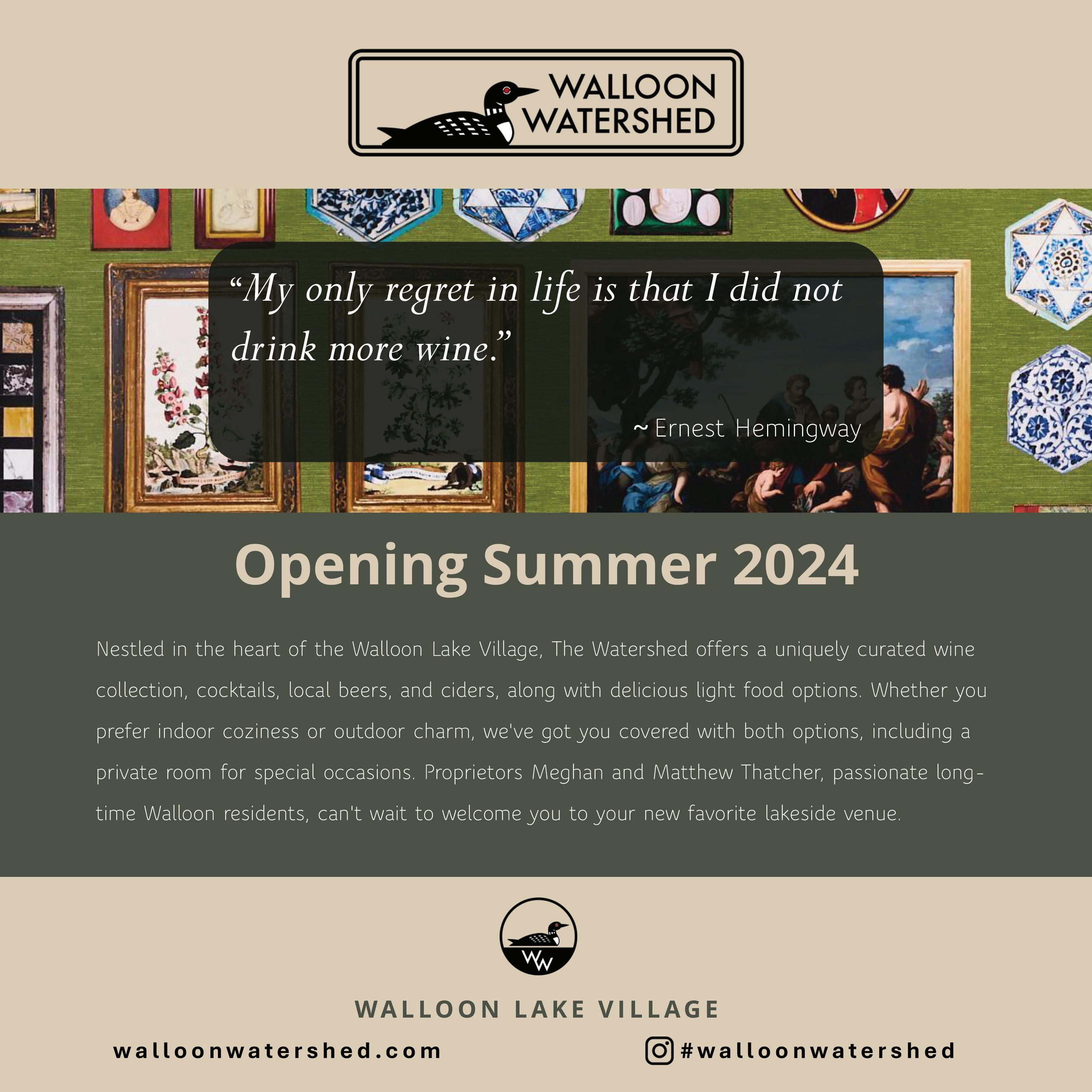Dave Fenstermaker and crew racing his 17 off of Indian Garden Point
Cover: Both old and new 17s gather at the starting line
Sailing on Walloon Lake is a time-honored tradition. In this latest edition of Welcome to Walloon I showcase one of the lake’s most famous icons, the 17 sailboat as it celebrates its 90th anniversary this summer. You’ll also hear a little about the lake’s “other sailboat,” the Snipe.
I’ve always been fascinated by what life was like on Walloon 50, 60, 70, or even 100 years ago. Capturing the stories directly from those who lived them and preserving their accounts is a passion of mine. In this article, you’ll get a glimpse into the past of what sailing life was like on Walloon and why it was at the center of early recreation on the lake.
To write this piece, my team and I reached out to several families, both past and present, who all have led storied lives of sailing over the years. Pinky McCutcheon, Ann and Jean Ringer, Sally Randall Swanson, and many other passionate 17 owners too numerous to mention here.
I’ve also provided a brief market update on Walloon in the center of this piece. The numbers don’t lie: if you think now might be a good time to test the market, I believe you won’t be disappointed.
A special thanks to everyone who makes Walloon the incredible place it is as we look forward to another exciting summer on the lake!
Walloon’s Sailing Legacies & Legends
Few things are more emblematic of a perfect summer day than sailing on Walloon Lake, and no boat is more iconic to the history of Walloon than the beloved 17. Designed specifically to respond to the unique conditions found on the lake, the lightweight hull can handle the shifting winds and waves beautifully. Their low beam-to-length ratio and large sail area-displacement make them exceptionally quick on the water and perfectly suited to Walloon, one of the only places in the world where you will find this special boat. We have one of the original members of the
Walloon Yacht Club, Bill Loughlin, to thank for the 17. An avid boater and student of naval architecture at the University of Michigan, Loughlin sought to design the ideal boat for sailing on Walloon in 1929. His first creation was the Walloon Lake One, better known simply as the “W,” a 20 feet longfinkeel sloop featuring a 17.28 square meter sail. After six years of navigating Walloon’s variable winds in the W, Loughlin made some adjustments, lengthening the hull to 25 feet and condensing the sail to exactly 17 square meters, thus crowning his new design the 17. The building of that first boat is something
of Walloon legend: over the course of a bitterly cold winter and spring, Loughlin and his good friend, Henry Cawthra, assembled the sailboat in the garage of Master’s Boat Works. As the winter of 1934 reached a deep freeze, the temperature drifted down to 40 below zero, and yet the boys kept on working, more determined than ever. Snow floated down into their workspace through gaps in the roof, and a space heater was employed to make the garage slightly more bearable. Some might say it was the promise of an idyllic summer of sailing that fueled their dedication to working through such frigid conditions.
The wood for the first 17 came from local lumber yards as Loughlin and Cawthra used oak for framing, red cedar for planking, white cedar for deck planking, and Sitka spruce for spars, with all fittings and iron keels cast by East Jordan Ironworks. It was an incredibly laborious process as the majority of the machining was done by hand to ensure exceptional craftsmanship. Loughlin and Cawthra then used scrap lumber to make patterns of each aspect of the design to aid them in the production of additional 17s.
In 1938, Loughlin sold his boat-building business to Ted McCutcheon, Sr., a skilled woodworker and boater whose family has been spending summers on Walloon for generations. His daughter, Margaret “Pinky” McCutcheon, an accomplished sailor in her own right, grew up watching her father build boats, vividly recalls
Snipe
Working the wind
the distinct scents of the mahogany, stains, paints, canvas, and varnishes used to make the original 17s. While reminiscing about a childhood spent at the boat shop, Pinky remembered that a rotting hull that littered their backyard next to the shop was transformed into a pirate ship for the children’s imaginative playtime. Still, she and her three brothers were put to work at times, with Pinky and her brother, Ted, earning “a nickel each for sweeping shavings and sawdust.” She was especially taken by the whimsical curly shavings from the masts and booms. Her father, Ted, is remembered as one of the most notable boat builders in Northern Michigan who perfected the

Today, at any given time, there are around twenty 17s on the lake, with the first twenty-five constructed of wood before fiberglass became the norm. If you’re not well versed in the nuances of sailboat design, the members of the 17 class can be identified by their famous insignia: the number 17 sitting inside of a square at the top of the sail. Each boat has a hull number, and that may be found about half way down the sail. The lower the number, the older the boat. Those who sail the 17s today not only honor the history of the vessel but also carry on the legacy of a singular type of sailing on Walloon.
Snipes racing in the West Arm 1948
news of the day, for kids to meet each other and form friendships and crushes. Days were spent sailing and swimming, while evenings consisted of conversation held over flat top grills, macaroni salad, and cherry pie on paper plates. It was a different era, with more free hours to be spent with the people and things you deeply enjoyed.
It cannot be overstated that wooden boats require a tremendous amount of upkeep and effort from their owners to maintain their beauty and functionality. One unique yearly event is to soak the hulls of these old beauties for a number of days early in the season. Soaking the hull swells the wooden boards together which, “hopefully” creates a “mostly” sealed wooden bottom. For decades, the 17s had cotton sails, which were easy to stuff into bags and transport but absorbed 17s in action
Currently, Mark Love is lovingly restoring that first 17 built in 1934, hull No. 1. Today, sailing is regarded as a hobby and a sport, but for the mid-century Walloon community, it was a way of life. It wasn’t easy to get around the lake, and so sailing served both practical and social purposes for people to connect with one another. It was a way for families and friends to get together and share the
Mark Love’s hull No.1 progress
A HUMBLE THANK YOU TO ALL Your Business Means the World to
Me
KALIN & MATT SHEICK—WALLOON LAKE, MI
“We knew right away we wanted to work with Wally because he’s the best. Everywhere we went in the Walloon Lake area people asked us if we had met Wally yet. We are no strangers to real estate, but the professionalism, honesty, genuine care & love of this area that Wally brings to every single transaction is unbeatable. Wally is one of the greatest assets to this community & anyone who works alongside him, or becomes his client can call themselves lucky.”
WALLY KIDD INVOLVED SALES ON WALLOON LAKE
DAVID & THERESA CROUSE—
WALLOON LAKE, MI
“Wally Kidd is the perfect agent. Not only is he a historian of Walloon Lake proper, but also, he has a tremendous sense of the market and made sure both buyer and sellers were happy in the end. He knows the market, inside and out. He has incredible contacts and it was through one of these contacts that led to the sale of the house. On a scale of one to five, I would rate Wally a ‘10’.”
KATHY FRECH—WALLOON LAKE, MI
“In 1888, our family built a cottage on the shores of Walloon Lake. Almost 120 years later it was time for us to sell our cherished possession and it was clear that there was only one realtor that could handle this important and emotional transaction for us...that was Wally Kidd. Finding a broker who we trusted was a must, finding one whose family has a similar, storied history on the lake was really unique. He clearly understood what it meant for my family to transfer the ownership of this cottage. He handled it beautifully. No one knows Walloon Lake like Wally Kidd!”
water and slowed you down, and then had to be laid out in the yard to dry. Despite the fuss, Sally Randall Swanson fondly remembers her postsailing ritual of spreading cotton sails over her family’s lawn, and then hoisting the spinnaker up a tree before tying it to nearby trees to dry in the wind. She was a lifelong sailor on Walloon, cruising across the lake for fun and regularly competing in the many races organized throughout the summer.
Trophies from the 1940s and 50s
The race culture of Walloon was established in the 1930s alongside the creation of the 17 and the equally popular snipe class. Sailing had become so fashionable by the late 1920s that the Walloon Yacht Club shifted its focus from power boats to sailing and began hosting an annual race series each summer. The shifting winds created by the surrounding hills paired with the lake’s unusual shape and irregular shoreline provided exceedingly challenging racing conditions, and thus, stronger and smarter sailors. Races were held at the foot and in the west arm. Inter-club races were organized with neighboring yacht clubs in Harbor Springs, Charlevoix, Burt Lake, and Crooked Lake.
Throughout the 1940s and 50s Walloon dominated those races, establishing a reputation as the area’s best competitive sailors.
A legacy of families have been dedicated to establishing and maintaining the 17 and snipe classes on Walloon Lake, as well as doing everything they can to keep the yacht club going: the Cawthras, the Krimendahls, the Habigs, the Kirks, the Mertens, the Brays, the Ryans, and countless others. It is their commitment to the art of racing on Walloon that the sport is what it is today.
Henry Cawthra is often referred to as the Babe Ruth of sailing on Walloon. He began sailing when
“SAILBOAT RACING IS JUST LIKE LIFE. IF YOU’RE AHEAD, NEVER TAKE YOUR EYE OFF THE COMPETITION AND CONSIDER THE OPTIONS IF THEY’RE MOVING AHEAD. IF YOU’RE BEHIND, YOU HAVE TO DO SOMETHING DIFFERENT.”
– Henry Cawthra
he was five years old and continued to sail every summer, at least three times a week, until he was 91. When Henry was young, he’d sit on the front porch of the family’s cottage, and if he saw another sailboat out on the lake, he would rush down to the water, get in his boat, and sail out to challenge them to a race. He was incredibly competitive and won more races than anyone on the lake, and when he didn’t win, he was trying to figure out how to fix it. His daughter, Carol Hopcraft, talks about how he “had a complete diary of every race, every wind current, every tiny breeze, every depth of the lake over the [race] course.” After each race, Henry and his crew, Brian Granger, Andy Allen, and Don Grimmer, would meet on the Hopcraft’s porch to drink gin and tonics and talk over the race. Henry
told Carol, “Sailboat racing is just like life. If you’re ahead, never take your eye off the competition and consider the options if they’re moving ahead. If you’re behind, you have to do something different.” He sailed in regattas all over the country, but Walloon was always “the home of his heart.”
Of course, not everyone who takes to the race waters of Walloon is in it to win. Jean Bippus Ringer and her sister Ann were avid snipe sailors who added some levity to the sailing scene in the 1950s by painting their
The Babe Ruth of Walloon Sailing
family boat pink and purple before christening it the “Hippo Bippomous.” There were thirteen snipes on the lake in those days, and out of those thirteen boats, the girls usually finished thirteenth in races, but they didn’t mind. They were on the water simply for the fun of it.
As Jean says, “The seriousness of their sailing prowess could be measured in the type of cookies they decided to take on board during the race that day.”
The beauty of sailing on Walloon is that everyone makes it exactly what they want it to be. There’s a lot of seriousness with the competitive racers, but there’s also a lot of play and fun antics. My dad, Jack Kidd, along with Trevy Warfield, confess to having put a bucket underneath Peg Ratliff and Ted McCutcheon’s boat to slow them down because they were always getting beat by them. Sally Randall Swanson remembers Al Cameron running aground a lot, while Frank Limbocher’s use of colorful language was always good for a laugh.
While Henry Cawthra was analyzing every aspect of the conditions on the lake, the more low-key sailors would watch the smoke from their cigarettes to determine the wind direction.
Some might argue that the races were just an excuse for the lively parties that followed the competition. Sailors tend to be boisterous extroverts, ever ready to have a fun time, whether on water or dry land. As such, the after race parties were always held on the front lawn of one
Snipe getting ready to race
The Ryan Family hard at “work”
of the racers’ cottages, with hosts rotating throughout the summer. Ann Warfield recalls kids ferrying in crews who anchored their boats when the docks were filled, and snacks, beer, and soft drinks in ample supply. Trevy Warfield’s father occasionally invited his buddies into the cottage for some adult beverages on the sly. The inter-club races held more formal events with dances and a big celebration after the Commodore’s Cup where awards would be given for accomplishments made over the season. These traditions still continue today, as the ritual of competing in a race, having a fun little party, and then sailing home will never lose their appeal.
Sailing has been at the center of Walloon Lake’s culture for over a century, and this summer, we’ll be celebrating of the 17 sailboat. While some
West Arm race day
Jim Ringer sailing No. 41
Sailing class at Camp Michigania, future 17 owners?
of the original wooden 17s have been retired, Bill Loughlin’s first design is currently being restored and Number 10 serves as an iconic landmark at the entrance to the Village. In the 1970s, Sally Randall Swanson helped to usher in a new chapter for the 17s with the purchase of the first fiberglass hull modeled from Ted McCutcheon’s wooden hull. It wasn’t an easy process: hull 25 was destroyed in a hurricane, so McCutcheon used 24 as a mold for the first fiberglass 17, but his first attempt ran into a series of issues. He and his team found success in 1972, producing the first functioning fiberglass 17, hull number 27, that is now owned by Sally’s daughter, Deb Odom Stern who was gifted the boat on her 40th birthday. This modern overhaul provides sailors with an anchor to the past within a vessel that is lighter, faster, and easier to maintain and reproduce. A number of
fiberglass 17s have been built in the decades that followed and are primarily what you’ll spot on the lake these days. They may have modern, state-of-the-art sails, but the hull design is exactly what folks were sailing in 90 years ago. The Walloon Yacht Club is still going strong, dedicated to its mission of encouraging sailing in all forms, preserving the natural beauty of the lake, and fostering friendship and good sportsmanship throughout the summer.
The Walloon Sailors provide sailing lessons for children and adults eager to join in on the fun and perhaps one day partake in a race. Today, these noted sailors are at the forefront of Walloon’s race culture: Philo Lang, John Kirk Jr., Stephen Kircher, the Scully family, Bill Bray, Frank Grossi, David Fenstermaker, and Sean and Patrick Ryan, to name a few. About twenty races are held each summer, and when sailors go out on race day, they’re following markers that were set by the generations that came before them. While every summer day on Walloon is picturesque, those racing days when the water is buzzing with an abundance of sailboats on the horizon are breathtaking and a reason why so many of us call this wonderful lake home.

